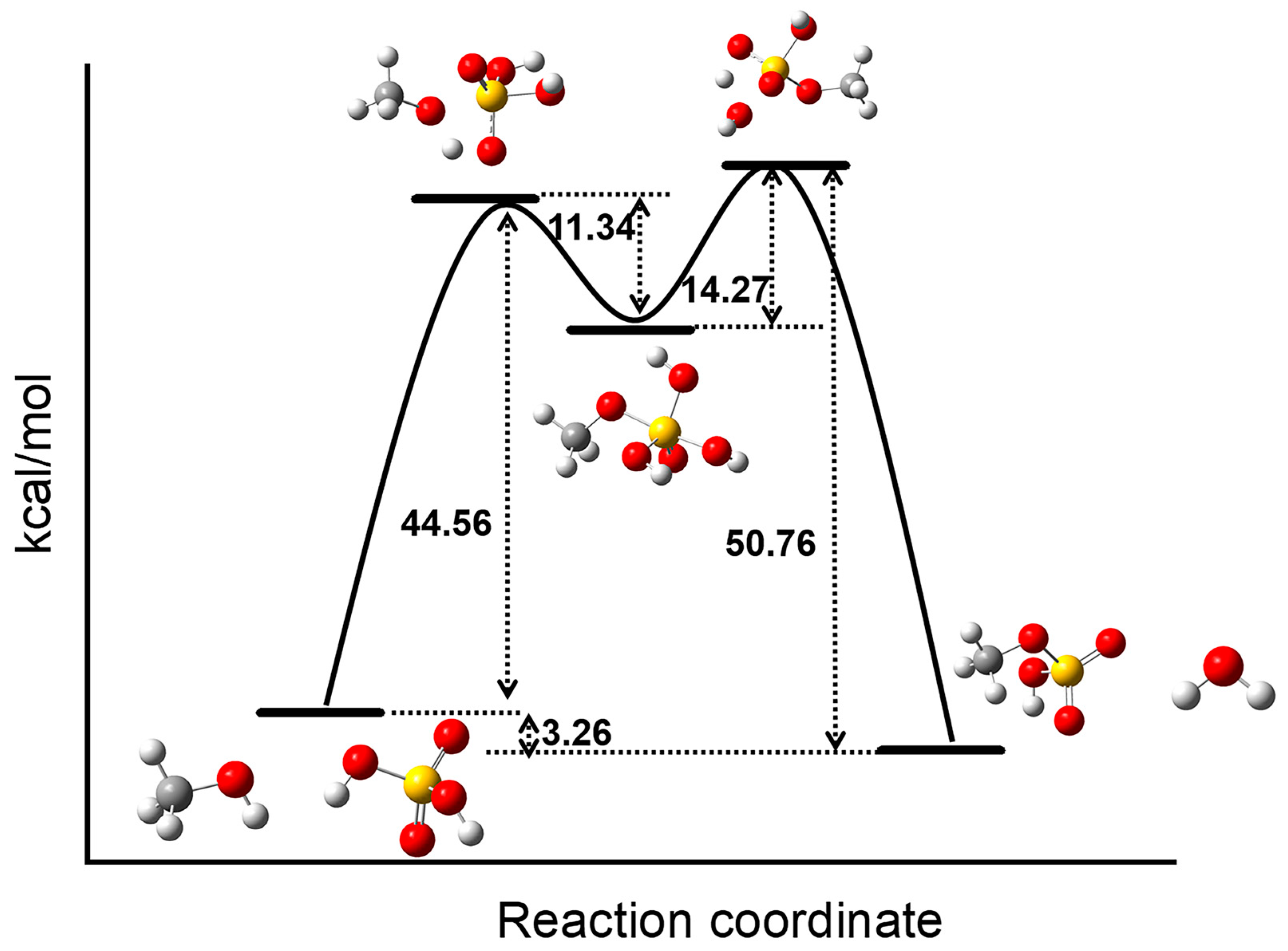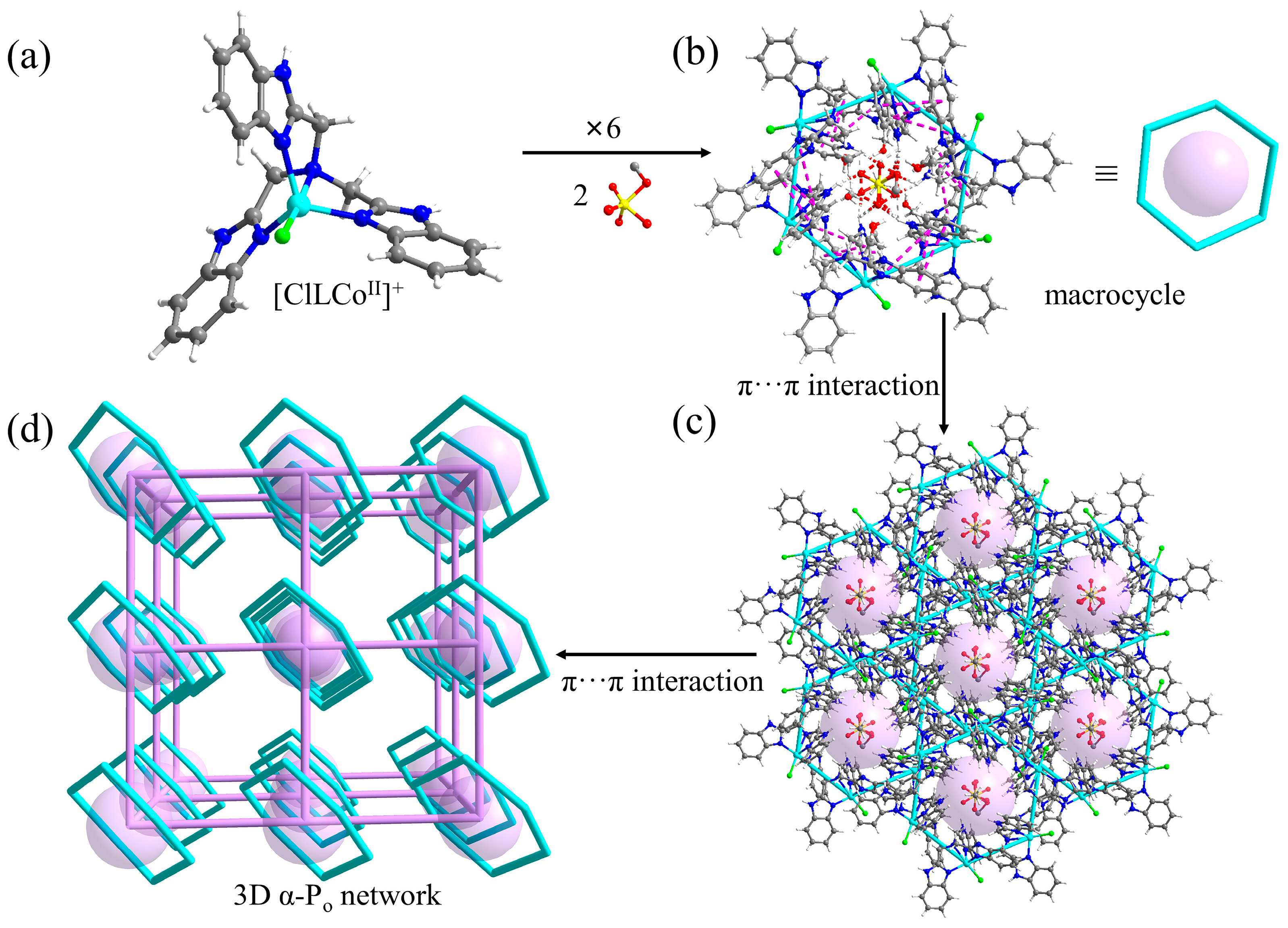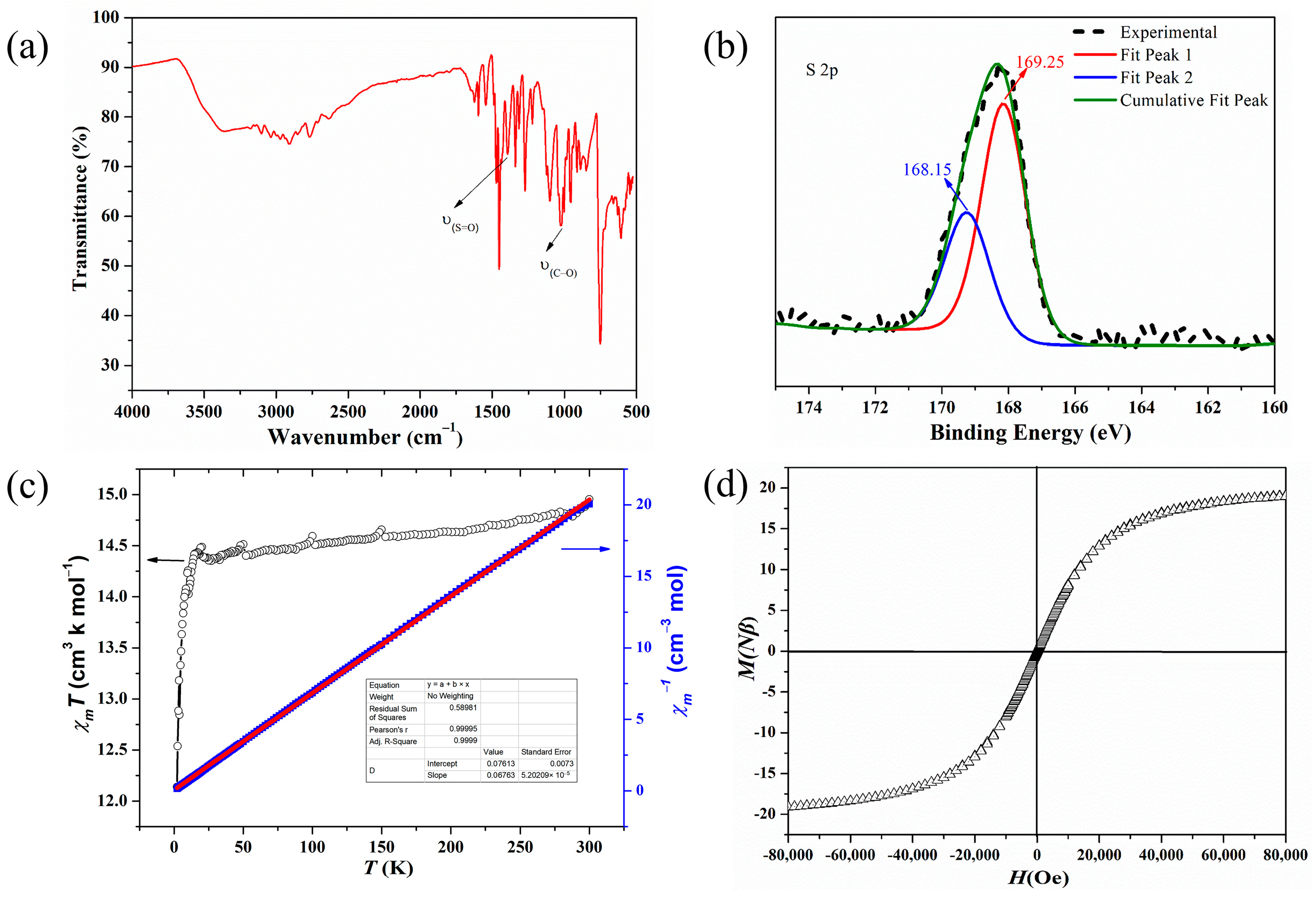Trapping an Ester Hydrate Intermediate in a π-Stacked Macrocycle with Multiple Hydrogen Bonds
Abstract
:1. Introduction
2. Results and Discussion
2.1. Trapping the Ester Hydrate Intermediate [CH3OSO2(OH)2]−
2.2. Physical-Property Characterization of Compound 1
3. Experimental Methods
3.1. Materials and Physical Measurements
3.2. Synthesis of Compound 1
3.3. Crystallography
3.4. Computational Methods
4. Conclusions
Supplementary Materials
Author Contributions
Funding
Institutional Review Board Statement
Informed Consent Statement
Data Availability Statement
Conflicts of Interest
Sample Availability
References
- Glisic, S.B.; Pajnik, J.M.; Orlović, A.M. Process and techno-economic analysis of green diesel production from waste vegetable oil and the comparison with ester type biodiesel production. Appl. Energy 2016, 170, 176–185. [Google Scholar] [CrossRef]
- Egle, S.; Violeta, M. Biodiesel fuel synthesis by interesterification of triglycerides with carboxylate esters of low molecular weight. Rev. Chem. Eng. 2021, 37, 259–276. [Google Scholar]
- Chen, H.; Zhang, R.; Luo, R.-H.; Yang, L.-M.; Wang, R.-R.; Hao, X.-J.; Zheng, Y.-T. Anti-HIV activities and mechanism of 12-o-tricosanoylphorbol-20-acetate, a novel phorbol ester from Ostodes katharinae. Molecules 2017, 22, 1498. [Google Scholar] [CrossRef] [Green Version]
- Kirumakki, S.R.; Nagaraju, N.; Chary, K.V.R. Esterification of alcohols with acetic acid over zeolites Hβ, HY and HZSM5. Appl. Catal. A-Gen. 2006, 299, 185–192. [Google Scholar]
- Miao, S.; Shanks, B.H. Mechanism of acetic acid esterification over sulfonic acid-functionalized mesoporous silica. J. Catal. 2011, 279, 136–143. [Google Scholar] [CrossRef]
- Iwasawa, T.; Hooley, R.J.; Rebek, J., Jr. Stabilization of labile carbonyl addition intermediates by a synthetic receptor. Science 2007, 317, 493–496. [Google Scholar]
- Yoshizawa, M.; Kusukawa, T.; Fujita, M.; Yamaguchi, K. Ship-in-a-bottle synthesis of otherwise labile cyclic trimers of siloxanes in a self-assembled coordination cage. J. Am. Chem. Soc. 2000, 122, 6311–6312. [Google Scholar] [CrossRef]
- Liu, Q.-K.; Ma, J.P.; Dong, Y.-B. Adsorption and separation of reactive aromatic isomers and generation and stabilization of their radicals within cadmium(II)-triazole metal-organic confined space in a single-crystal-to-single-crystal fashion. J. Am. Chem. Soc. 2010, 132, 7005–7017. [Google Scholar] [CrossRef]
- Ning, G.-H.; Inokuma, Y.; Fujita, M. Stable encapsulation of acrylate esters in networked molecular capsules. Chem.-Asian J. 2014, 9, 466–468. [Google Scholar] [PubMed]
- Schwarzmaier, C.; Schindler, A.; Heindl, C.; Scheuermayer, S.; Peresypkina, E.V.; Virovets, A.V.; Neumeier, M.; Gschwind, R.; Scheer, M. Stabilization of tetrahedral P4 and As4 molecules as guests in polymeric and spherical environments. Angew. Chem. Int. Ed. 2013, 52, 10896–10899. [Google Scholar] [CrossRef]
- Kaanumalle, L.S.; Nithyanandhan, J.; Pattabiraman, M.; Jayaraman, N.; Ramamurthy, V. Water-soluble dendrimers as photochemical reaction media: Chemical behavior of singlet and triplet radical pairs inside dendritic reaction cavities. J. Am. Chem. Soc. 2004, 126, 8999–9006. [Google Scholar] [CrossRef]
- Eelkema, R.; Maeda, K.; Odell, B.; Anderson, H.L. Radical Cation Stabilization in a Cucurbituril Oligoaniline Rotaxane. J. Am. Chem. Soc. 2007, 129, 12384–12385. [Google Scholar] [CrossRef]
- Liu, Y.; Shi, J.; Chen, Y.; Ke, C.-F. A polymeric pseudorotaxane constructed from cucurbituril and aniline, and stabilization of its radical cation. Angew. Chem. Int. Ed. 2008, 47, 7293–7296. [Google Scholar] [CrossRef]
- Shi, J.; Chen, Y.; Wang, Q.; Liu, Y. Construction and efficient radical cation stabilization of cyclodextrin/aniline polypseudorotaxane and its conjugate with carbon nanotubes. Adv. Mater. 2010, 22, 2575–2578. [Google Scholar] [CrossRef] [PubMed]
- Wei, W.; Li, W.L.; Li, Z.F.; Su, W.P.; Hong, M.C. Stabilization and controlled release of reactive molecules by solid-state van der waals capsules. Chem.–Eur. J. 2013, 19, 468–472. [Google Scholar] [CrossRef] [PubMed]
- Galan, A.; Ballester, P. Stabilization of reactive species by supramolecular encapsulation. Chem. Soc. Rev. 2016, 45, 1720–1737. [Google Scholar] [CrossRef] [PubMed]
- Mal, P.; Breiner, B.; Rissanen, K.; Nitschke, J.R. White phosphorus is air-stable within a self-assembled tetrahedral capsule. Science 2009, 324, 1697–1699. [Google Scholar] [CrossRef]
- Jiao, T.Y.; Chen, L.; Yang, D.; Li, X.; Wu, G.C.; Zeng, P.M.; Zhou, A.K.; Yin, Q.; Pan, Y.J.; Wu, B.; et al. Trapping white phosphorus within a purely organic molecular container produced by imine condensation. Angew. Chem. Int. Ed. 2017, 56, 14545–14550. [Google Scholar] [CrossRef] [PubMed]
- Yang, D.; Zhao, J.; Yu, L.; Lin, X.S.; Zhang, W.Y.; Ma, H.W.; Gogoll, A.; Zhang, Z.B.; Wang, Y.Y.; Yang, X.-J.; et al. Air- and light-stable P4 and As4 within an anion-coordination-based tetrahedral cage. J. Am. Chem. Soc. 2017, 139, 5946–5951. [Google Scholar] [CrossRef]
- Sano, T.; Masuda, R.; Sase, S.; Goto, K. Isolable small-molecule cysteine sulfenic acid. Chem. Commun. 2021, 57, 2479. [Google Scholar] [CrossRef] [PubMed]
- Kumar, M.R.; Farmer, P.J. Trapping reactions of the sulfenyl and sulfinyl tautomers of sulfenic acids. ACS Chem. Biol. 2017, 12, 474–478. [Google Scholar] [CrossRef] [PubMed]
- Liu, C.T.; Benkovic, S.J. Capturing a sulfenic acid with arylboronic acids and benzoxaborole. J. Am. Chem. Soc. 2013, 135, 14544–14547. [Google Scholar] [CrossRef]
- Saiki, T.; Goto, K.; Okazaki, R. Isolation and X-ray crystallographic analysis of a stable selenenic acid. Angew. Chem. Int. Ed. 1997, 36, 2223. [Google Scholar] [CrossRef]
- Goto, K.; Saiki, T.; Akine, S.; Kawashima, T.; Okazaki, R. Synthesis and reactions of conformational isomers of a stable selenenic acid bearing a bridged calix [6] arene framework. Heteroat. Chem. 2001, 12, 195–197. [Google Scholar]
- Kei, G.; Yoko, H.; Yusuke, T.; Takayuki, K.; Gaku, Y.; Nozomi, T.; Shigeru, N. Synthesis, structure, and reactions of the first stable aromatic S-nitrosothiol bearing a novel dendrimer-type steric protection group. Chem. Lett. 2001, 30, 1204–1205. [Google Scholar]
- Goto, K.; Hino, Y.; Kawashima, T.; Kaminag, M.; Yano, E.; Yamamoto, G.; Takagic, N.; Nagase, S. Synthesis and crystal structure of a stable S-nitrosothiol bearing a novel steric protection group and of the corresponding S-nitrothiol. Tetrahedron Lett. 2000, 41, 8479–8483. [Google Scholar] [CrossRef]
- Okazaki, R.; Goto, K. Synthesis of highly reactive organosulfur compounds. Heteroat. Chem. 2002, 13, 414–418. [Google Scholar] [CrossRef]
- Shimada, K.; Goto, K.; Kawashima, T.; Takagi, N.; Choe, Y.-K.; Nagase, S. Isolation of a Se-nitrososelenol: A new class of reactive nitrogen species relevant to protein Se-nitrosation. J. Am. Chem. Soc. 2004, 126, 13238–13239. [Google Scholar]
- Goto, K.; Kawashima, T. Nanoscale molecular cavities for stabilization of highly reactive species. J. Syn. Org. Chem. Jpn. 2005, 63, 1157–1170. [Google Scholar] [CrossRef]
- Kawamichi, T.; Haneda, T.; Kawano, M.; Fujita, M. X-ray observation of a transient hemiaminal trapped in a porous network. Nature 2009, 461, 633–635. [Google Scholar] [CrossRef]
- Li, S.; Li, G.-L.; Wang, W.; Liu, Y.; Cao, Z.-M.; Cao, X.-L. A 2D metal-organic framework interpenetrated by a 2D supramolecular framework assembled by CH/π interactions. Inorg. Chem. Commun. 2021, 130, 108705. [Google Scholar] [CrossRef]
- Li, L.-L.; Huang, M.; Chen, T.; Xu, X.-F.; Zhuo, Z.; Wang, W.; Huang, Y.-G. A porous π-stacked self-assembly of cup-shaped palladium complex for iodine capture. Molecules 2023, 28, 2881. [Google Scholar] [CrossRef]
- Chen, T.; Li, S.; Wang, Z.-B.; Wu, Z.-Y.; Huang, M.; Wang, W.; Zhuo, Z.; Huang, Y.-G. Iodine uptake enhanced electrical conductivity by a metal-organic framework bearing nanotube array of π-stacked columns. J. Mol. Struct. 2023, 1289, 135858. [Google Scholar] [CrossRef]
- Li, G.-L.; Zhuo, Z.; Wang, B.; Cao, X.-L.; Su, H.-F.; Wang, W.; Huang, Y.-G.; Hong, M.-C. Constructing π-stacked supramolecular cage based hierarchical self-assemblies via π···π stacking and hydrogen bonding. J. Am. Chem. Soc. 2021, 143, 10920–10929. [Google Scholar] [CrossRef]
- Liu, J.; Lu, Z.-X.; Wu, F.-F.; Wang, B.; Cao, X.-L.; Wang, W.; Zhuo, Z.; Li, Q.-H.; Huang, Y.-G. A chiral SrSi2 (srs) superstructure constructed by a dual interaction system showing isotropic electrical conductivity. Chin. Chem. Lett. 2022, 1001, 108100. [Google Scholar] [CrossRef]
- Xie, J.-H.; Tan, Y.-Z.; Li, Z.-H.; Zhou, Q.; Ou, G.-C. Synthesis, crystal structures, and theoretical calculations of two diverse three-dimensional hybrid materials based on polyoxoanions bridging macrocyclic copper/nickel complex. Inorg. Nano-Met. Chem. 2021, 51, 889–895. [Google Scholar] [CrossRef]
- Simon, A.; Kriegsmann, H. Schwingungsspektren von alkylderivaten der schwefligen säure, I. Mitteil.: Raman- und IR-spektren der alkali-methansulfonate. Chem. Ber. 1956, 89, 1718–1726. [Google Scholar] [CrossRef]
- Chihara, G. Characteristic infrared absorption band of organic sulfate esters. Chem. Pharm. Bull. 1958, 6, 114. [Google Scholar] [CrossRef] [Green Version]
- Zhang, L.; Li, Z.; Yang, Y.; Zhou, Y.; Li, J.; Si, L.; Kong, B. Research on the composition and distribution of organic sulfur in coal. Molecules 2016, 21, 630. [Google Scholar] [CrossRef] [Green Version]
- Wibowo, E.S.; Park, B.-D. Chemical and thermal characteristics of ion-exchanged lignosulfonate. Molecules 2023, 28, 2755. [Google Scholar] [CrossRef]
- Yang, E.C.; Hendrickson, D.N.; Wernsdorfer, W.; Nakano, M.; Zakharov, L.N.; Sommer, R.D.; Rheingold, A.L.; Ledezma-Gairaud, M.; Christou, G. Cobalt single-molecule magnet. J. Appl. Phys. 2002, 91, 7382–7384. [Google Scholar] [CrossRef] [Green Version]
- Ostrovsky, S.M.; Falk, K.; Pelikan, J.; Brown, D.A.; Tomkowicz, Z.; Haase, W. Orbital angular momentum contribution to the magneto-optical behavior of a binuclear cobalt(II) complex. Inorg. Chem. 2006, 2, 688–694. [Google Scholar]
- Matsuoka, R.; Yoshimoto, T.; Kitagawa, Y.; Kusamoto, T. Structural and Magnetic Studies on Nickel(II) and Cobalt(II) Complexes with Polychlorinated Diphenyl(4-pyridyl)methyl Radical Ligands. Molecules 2021, 26, 5596. [Google Scholar] [CrossRef]
- Guo, L.R.; Zhu, F.; Chen, Y.; Li, Y.Z.; Zheng, L.M. Layered copper compounds based on 4-(3-bromothienyl) phosphonate (BTP): Weak ferromagnetism observed in [Cu2(4,4′-bpy)0.5(BTP)2]·H2O. Dalton Trans. 2009, 40, 8548–8554. [Google Scholar] [CrossRef]
- Azuma, M.; Kaimori, S.; Takano, M. High-pressure synthesis and magnetic properties of layered double perovskites Ln2CuMO6 (Ln = La, Pr, Nd, and Sm; M = Sn and Zr). Chem. Mater. 1998, 10, 3124–3130. [Google Scholar] [CrossRef]
- Zhang, S.R.; Du, D.Y.; Qin, J.S.; Bao, S.J.; Li, S.L.; He, W.W.; Lan, Y.Q.; Shen, P.; Su, Z.M. A fluorescent sensor for highly selective detection of nitroaromatic explosives based on a 2D, extremely stable, metal–organic framework. Chem. Eur. J. 2014, 20, 3589–3594. [Google Scholar] [CrossRef]
- Sheldrick, G.M. SHELXTL-integrated space-group and crystal-structure determination. Acta Crystallogr. 2015, A71, 3–8. [Google Scholar]
- Dolomanov, O.V.; Bourhis, L.J.; Gildea, R.J.; Howard, J.A.K.; Puschmann, H. OLEX2: A complete structure solution, refinement and analysis program. J. Appl. Cryst. 2009, 42, 339–341. [Google Scholar] [CrossRef]
- Zhao, Y.; González-García, N.; Truhlar, D.G. Benchmark database of barrier heights for heavy atom transfer, nucleophilic substitution, association, and unimolecular reactions and its use to test theoretical methods. J. Phys. Chem. A 2005, 109, 2012–2018. [Google Scholar] [CrossRef] [Green Version]
- Gonzalez, C.; Schlegel, H.B. Reaction path following in mass-weighted internal coordinates. J. Phys. Chem. 1990, 94, 5523–5527. [Google Scholar] [CrossRef]
- Frisch, M.J.; Trucks, G.W.; Schlegel, H.B.; Scuseria, G.E.; Robb, M.A.; Cheeseman, J.R.; Scalmani, G.; Barone, V.; Petersson, G.A.; Nakatsuji, H.; et al. Gaussian 16 Rev. B.01; Gaussian Inc.: Wallingford, CT, USA, 2016. [Google Scholar]



Disclaimer/Publisher’s Note: The statements, opinions and data contained in all publications are solely those of the individual author(s) and contributor(s) and not of MDPI and/or the editor(s). MDPI and/or the editor(s) disclaim responsibility for any injury to people or property resulting from any ideas, methods, instructions or products referred to in the content. |
© 2023 by the authors. Licensee MDPI, Basel, Switzerland. This article is an open access article distributed under the terms and conditions of the Creative Commons Attribution (CC BY) license (https://creativecommons.org/licenses/by/4.0/).
Share and Cite
Wang, B.; Nan, Z.-A.; Li, Q.; Liu, J.; Lu, Z.-X.; Wang, W.; Zhuo, Z.; Li, G.-L.; Huang, Y.-G. Trapping an Ester Hydrate Intermediate in a π-Stacked Macrocycle with Multiple Hydrogen Bonds. Molecules 2023, 28, 5705. https://doi.org/10.3390/molecules28155705
Wang B, Nan Z-A, Li Q, Liu J, Lu Z-X, Wang W, Zhuo Z, Li G-L, Huang Y-G. Trapping an Ester Hydrate Intermediate in a π-Stacked Macrocycle with Multiple Hydrogen Bonds. Molecules. 2023; 28(15):5705. https://doi.org/10.3390/molecules28155705
Chicago/Turabian StyleWang, Bin, Zi-Ang Nan, Qing Li, Jin Liu, Zi-Xiu Lu, Wei Wang, Zhu Zhuo, Guo-Ling Li, and You-Gui Huang. 2023. "Trapping an Ester Hydrate Intermediate in a π-Stacked Macrocycle with Multiple Hydrogen Bonds" Molecules 28, no. 15: 5705. https://doi.org/10.3390/molecules28155705
APA StyleWang, B., Nan, Z.-A., Li, Q., Liu, J., Lu, Z.-X., Wang, W., Zhuo, Z., Li, G.-L., & Huang, Y.-G. (2023). Trapping an Ester Hydrate Intermediate in a π-Stacked Macrocycle with Multiple Hydrogen Bonds. Molecules, 28(15), 5705. https://doi.org/10.3390/molecules28155705





